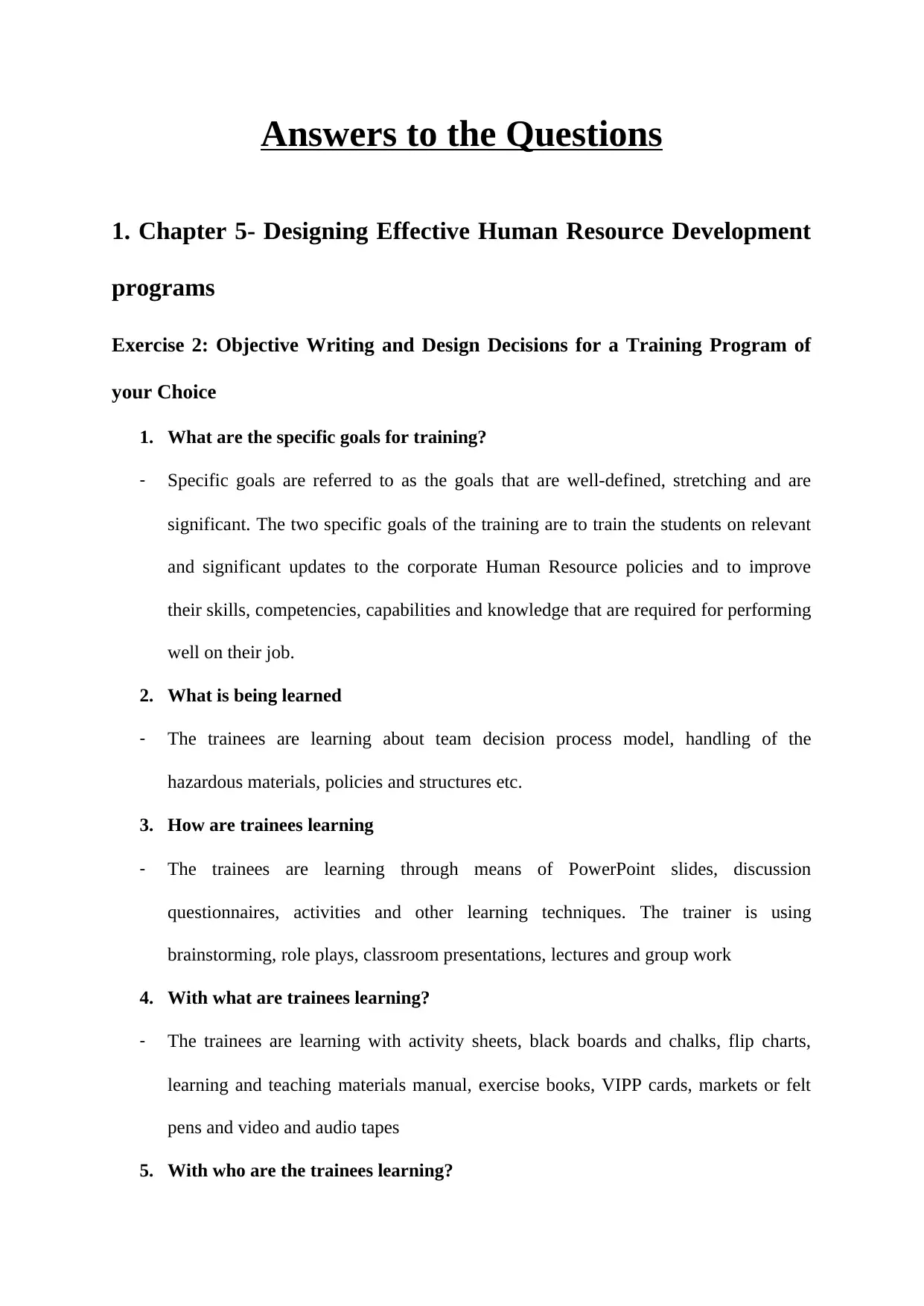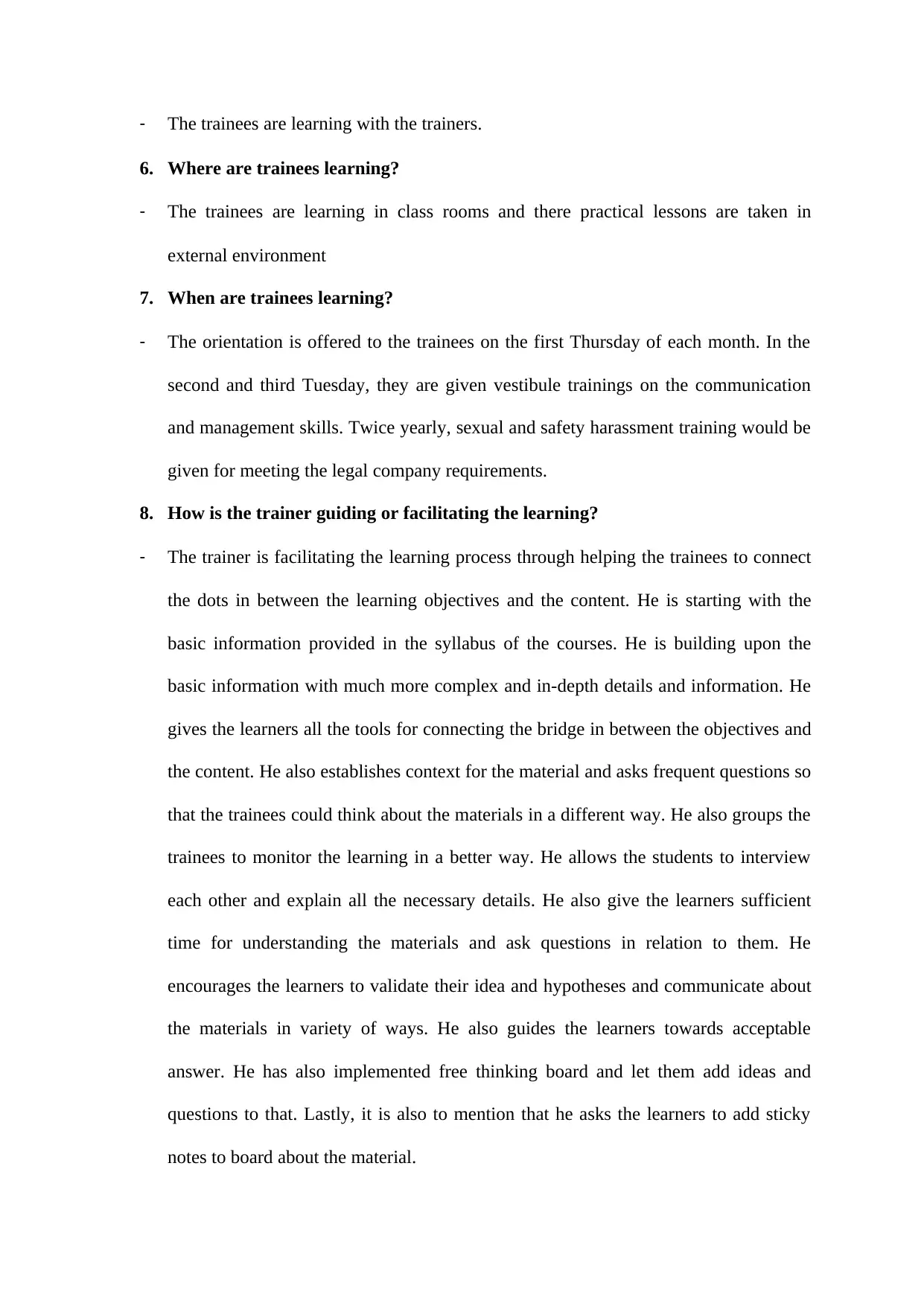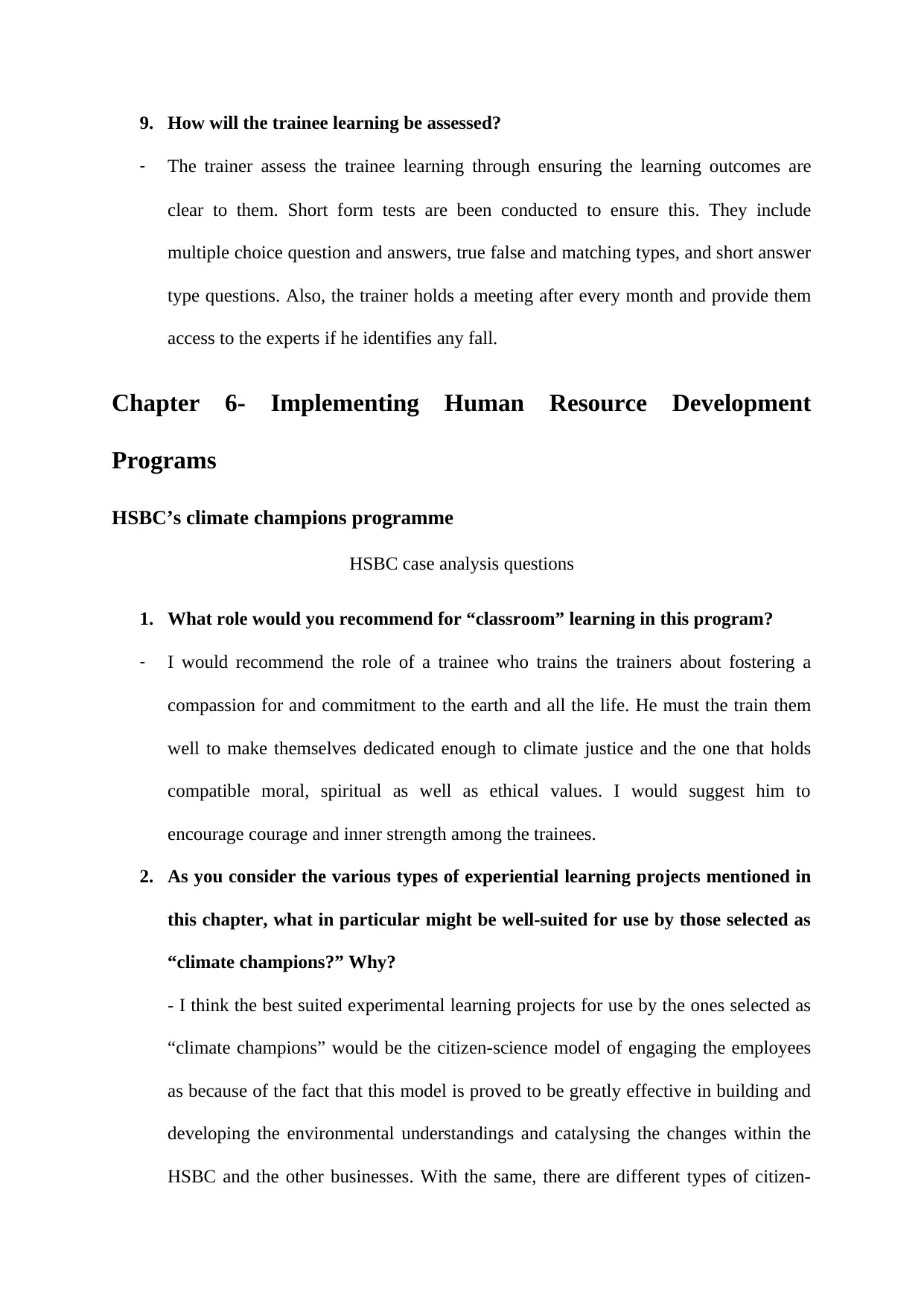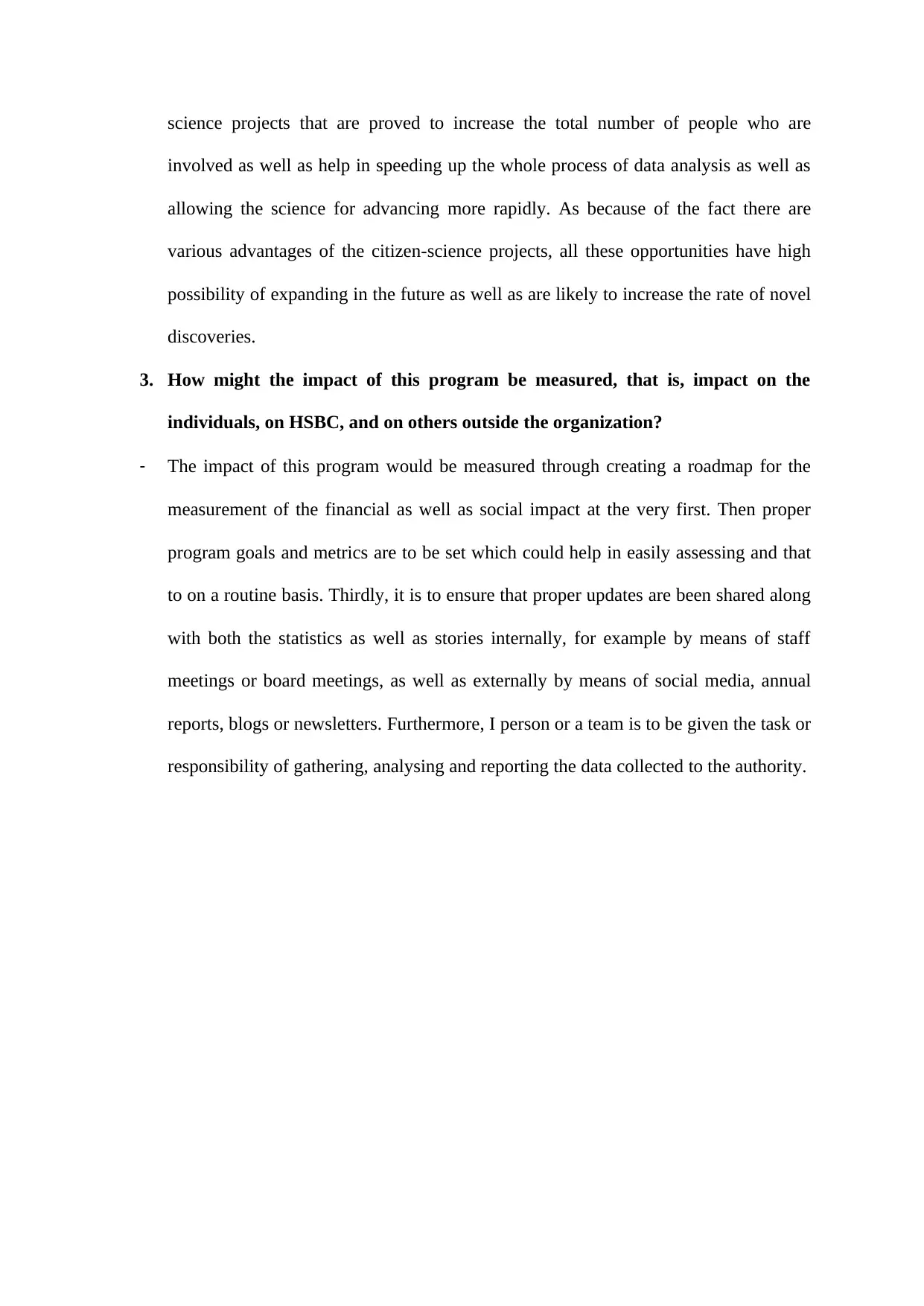HRM 6113 Summer A-18: Workforce Planning, HRD Programs, HSBC Analysis
VerifiedAdded on 2023/06/12
|5
|1099
|401
Homework Assignment
AI Summary
This assignment focuses on workforce planning, specifically addressing the design and implementation of effective Human Resource Development (HRD) programs. It includes an exercise on objective writing and design decisions for a training program, covering aspects like specific training goals, learning content, training methods, resources, and trainee assessment. Additionally, it presents a case analysis of HSBC's climate champions program, exploring the role of classroom learning, suitable experiential learning projects, and methods for measuring the program's impact on individuals, HSBC, and external stakeholders. The assignment provides detailed insights into creating and evaluating HRD initiatives within a corporate context.

Running head: WORKFORCE PLANNING
Workforce Planning
Name of the Student:
Name of the University:
Author note:
Workforce Planning
Name of the Student:
Name of the University:
Author note:
Paraphrase This Document
Need a fresh take? Get an instant paraphrase of this document with our AI Paraphraser

Answers to the Questions
1. Chapter 5- Designing Effective Human Resource Development
programs
Exercise 2: Objective Writing and Design Decisions for a Training Program of
your Choice
1. What are the specific goals for training?
- Specific goals are referred to as the goals that are well-defined, stretching and are
significant. The two specific goals of the training are to train the students on relevant
and significant updates to the corporate Human Resource policies and to improve
their skills, competencies, capabilities and knowledge that are required for performing
well on their job.
2. What is being learned
- The trainees are learning about team decision process model, handling of the
hazardous materials, policies and structures etc.
3. How are trainees learning
- The trainees are learning through means of PowerPoint slides, discussion
questionnaires, activities and other learning techniques. The trainer is using
brainstorming, role plays, classroom presentations, lectures and group work
4. With what are trainees learning?
- The trainees are learning with activity sheets, black boards and chalks, flip charts,
learning and teaching materials manual, exercise books, VIPP cards, markets or felt
pens and video and audio tapes
5. With who are the trainees learning?
1. Chapter 5- Designing Effective Human Resource Development
programs
Exercise 2: Objective Writing and Design Decisions for a Training Program of
your Choice
1. What are the specific goals for training?
- Specific goals are referred to as the goals that are well-defined, stretching and are
significant. The two specific goals of the training are to train the students on relevant
and significant updates to the corporate Human Resource policies and to improve
their skills, competencies, capabilities and knowledge that are required for performing
well on their job.
2. What is being learned
- The trainees are learning about team decision process model, handling of the
hazardous materials, policies and structures etc.
3. How are trainees learning
- The trainees are learning through means of PowerPoint slides, discussion
questionnaires, activities and other learning techniques. The trainer is using
brainstorming, role plays, classroom presentations, lectures and group work
4. With what are trainees learning?
- The trainees are learning with activity sheets, black boards and chalks, flip charts,
learning and teaching materials manual, exercise books, VIPP cards, markets or felt
pens and video and audio tapes
5. With who are the trainees learning?

- The trainees are learning with the trainers.
6. Where are trainees learning?
- The trainees are learning in class rooms and there practical lessons are taken in
external environment
7. When are trainees learning?
- The orientation is offered to the trainees on the first Thursday of each month. In the
second and third Tuesday, they are given vestibule trainings on the communication
and management skills. Twice yearly, sexual and safety harassment training would be
given for meeting the legal company requirements.
8. How is the trainer guiding or facilitating the learning?
- The trainer is facilitating the learning process through helping the trainees to connect
the dots in between the learning objectives and the content. He is starting with the
basic information provided in the syllabus of the courses. He is building upon the
basic information with much more complex and in-depth details and information. He
gives the learners all the tools for connecting the bridge in between the objectives and
the content. He also establishes context for the material and asks frequent questions so
that the trainees could think about the materials in a different way. He also groups the
trainees to monitor the learning in a better way. He allows the students to interview
each other and explain all the necessary details. He also give the learners sufficient
time for understanding the materials and ask questions in relation to them. He
encourages the learners to validate their idea and hypotheses and communicate about
the materials in variety of ways. He also guides the learners towards acceptable
answer. He has also implemented free thinking board and let them add ideas and
questions to that. Lastly, it is also to mention that he asks the learners to add sticky
notes to board about the material.
6. Where are trainees learning?
- The trainees are learning in class rooms and there practical lessons are taken in
external environment
7. When are trainees learning?
- The orientation is offered to the trainees on the first Thursday of each month. In the
second and third Tuesday, they are given vestibule trainings on the communication
and management skills. Twice yearly, sexual and safety harassment training would be
given for meeting the legal company requirements.
8. How is the trainer guiding or facilitating the learning?
- The trainer is facilitating the learning process through helping the trainees to connect
the dots in between the learning objectives and the content. He is starting with the
basic information provided in the syllabus of the courses. He is building upon the
basic information with much more complex and in-depth details and information. He
gives the learners all the tools for connecting the bridge in between the objectives and
the content. He also establishes context for the material and asks frequent questions so
that the trainees could think about the materials in a different way. He also groups the
trainees to monitor the learning in a better way. He allows the students to interview
each other and explain all the necessary details. He also give the learners sufficient
time for understanding the materials and ask questions in relation to them. He
encourages the learners to validate their idea and hypotheses and communicate about
the materials in variety of ways. He also guides the learners towards acceptable
answer. He has also implemented free thinking board and let them add ideas and
questions to that. Lastly, it is also to mention that he asks the learners to add sticky
notes to board about the material.
⊘ This is a preview!⊘
Do you want full access?
Subscribe today to unlock all pages.

Trusted by 1+ million students worldwide

9. How will the trainee learning be assessed?
- The trainer assess the trainee learning through ensuring the learning outcomes are
clear to them. Short form tests are been conducted to ensure this. They include
multiple choice question and answers, true false and matching types, and short answer
type questions. Also, the trainer holds a meeting after every month and provide them
access to the experts if he identifies any fall.
Chapter 6- Implementing Human Resource Development
Programs
HSBC’s climate champions programme
HSBC case analysis questions
1. What role would you recommend for “classroom” learning in this program?
- I would recommend the role of a trainee who trains the trainers about fostering a
compassion for and commitment to the earth and all the life. He must the train them
well to make themselves dedicated enough to climate justice and the one that holds
compatible moral, spiritual as well as ethical values. I would suggest him to
encourage courage and inner strength among the trainees.
2. As you consider the various types of experiential learning projects mentioned in
this chapter, what in particular might be well-suited for use by those selected as
“climate champions?” Why?
- I think the best suited experimental learning projects for use by the ones selected as
“climate champions” would be the citizen-science model of engaging the employees
as because of the fact that this model is proved to be greatly effective in building and
developing the environmental understandings and catalysing the changes within the
HSBC and the other businesses. With the same, there are different types of citizen-
- The trainer assess the trainee learning through ensuring the learning outcomes are
clear to them. Short form tests are been conducted to ensure this. They include
multiple choice question and answers, true false and matching types, and short answer
type questions. Also, the trainer holds a meeting after every month and provide them
access to the experts if he identifies any fall.
Chapter 6- Implementing Human Resource Development
Programs
HSBC’s climate champions programme
HSBC case analysis questions
1. What role would you recommend for “classroom” learning in this program?
- I would recommend the role of a trainee who trains the trainers about fostering a
compassion for and commitment to the earth and all the life. He must the train them
well to make themselves dedicated enough to climate justice and the one that holds
compatible moral, spiritual as well as ethical values. I would suggest him to
encourage courage and inner strength among the trainees.
2. As you consider the various types of experiential learning projects mentioned in
this chapter, what in particular might be well-suited for use by those selected as
“climate champions?” Why?
- I think the best suited experimental learning projects for use by the ones selected as
“climate champions” would be the citizen-science model of engaging the employees
as because of the fact that this model is proved to be greatly effective in building and
developing the environmental understandings and catalysing the changes within the
HSBC and the other businesses. With the same, there are different types of citizen-
Paraphrase This Document
Need a fresh take? Get an instant paraphrase of this document with our AI Paraphraser

science projects that are proved to increase the total number of people who are
involved as well as help in speeding up the whole process of data analysis as well as
allowing the science for advancing more rapidly. As because of the fact there are
various advantages of the citizen-science projects, all these opportunities have high
possibility of expanding in the future as well as are likely to increase the rate of novel
discoveries.
3. How might the impact of this program be measured, that is, impact on the
individuals, on HSBC, and on others outside the organization?
- The impact of this program would be measured through creating a roadmap for the
measurement of the financial as well as social impact at the very first. Then proper
program goals and metrics are to be set which could help in easily assessing and that
to on a routine basis. Thirdly, it is to ensure that proper updates are been shared along
with both the statistics as well as stories internally, for example by means of staff
meetings or board meetings, as well as externally by means of social media, annual
reports, blogs or newsletters. Furthermore, I person or a team is to be given the task or
responsibility of gathering, analysing and reporting the data collected to the authority.
involved as well as help in speeding up the whole process of data analysis as well as
allowing the science for advancing more rapidly. As because of the fact there are
various advantages of the citizen-science projects, all these opportunities have high
possibility of expanding in the future as well as are likely to increase the rate of novel
discoveries.
3. How might the impact of this program be measured, that is, impact on the
individuals, on HSBC, and on others outside the organization?
- The impact of this program would be measured through creating a roadmap for the
measurement of the financial as well as social impact at the very first. Then proper
program goals and metrics are to be set which could help in easily assessing and that
to on a routine basis. Thirdly, it is to ensure that proper updates are been shared along
with both the statistics as well as stories internally, for example by means of staff
meetings or board meetings, as well as externally by means of social media, annual
reports, blogs or newsletters. Furthermore, I person or a team is to be given the task or
responsibility of gathering, analysing and reporting the data collected to the authority.
1 out of 5
Related Documents
Your All-in-One AI-Powered Toolkit for Academic Success.
+13062052269
info@desklib.com
Available 24*7 on WhatsApp / Email
![[object Object]](/_next/static/media/star-bottom.7253800d.svg)
Unlock your academic potential
Copyright © 2020–2025 A2Z Services. All Rights Reserved. Developed and managed by ZUCOL.




